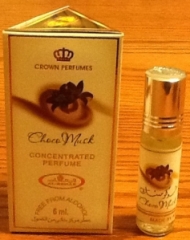The innocence of childhood pleasures as experienced through the prism of sugared almonds. That is the essence of Confetto, one of two Profumum Roma fragrances that celebrates the joy of almonds. However, it takes a very different approach from its more masculine counterpart, Antico Caruso. With Confetto, the focus is purely gourmand in nature, centered around a fluffy, very unisex, pink and white confection infused with vanilla.
Confetto is a concentrated eau de parfum that was released in 1996. Profumum has a lovely description of it on their website:
Both woman and child.
Capricious and gentle like a curl in the wind,
like candy floss, like a black silk
petticoat raised by the swirl of the merry go round.
Outspreads harmoniously to recall innocent or maybe forbidden delicacies.
[Notes:] Almond, anise, musk, amber, vanilla.
Confetto opens on my skin with sugared almonds, vanilla, and a clean white musk, trailed by a hint of fresh, green anise. It’s a very sugared scent, redolent of cotton candy and hyper-saturated carnival treats, but it’s actually less sweet than I had anticipated. Profumum’s gourmands are renowned for being quite over-the-top, undoubtedly due to their singular focus and extremely concentrated nature, but I’ve certainly smelled much sweeter, more syrupy fragrances lately than Confetto. (I shall endeavour not to bring up my trauma at the hands of Fusion Sacrée (Lui), yet again.)
It’s a relative matter, I grant you. On the sweetness scale of 10, I would firmly place most of the Profumum’s gourmands at around an 8 or so. That said, Confetto still surprised me a little, especially in the opening hour when there was a tiny touch of freshness, thanks to the anise. Confetto’s white musk also adds to that sense, though I find it too sharp for quite a few hours. (I loathe white musk, so put that comment into context.) The other helpful aspect is that Confetto is much lighter in feel than many of its siblings in the line which seem positively opaque in comparison. It certainly is airier, fluffier, and drier than Dulcis in Fundo, a waffle cones and vanilla scent that is exceptionally rich. So, for me, Confetto would initially rank as a 7 on the sweetness scale, before moving up to an 8, while Dulcis in Fundo would be a consistent 9.
From afar, Confetto smells primarily of “Jordan almonds” or Italian “confetti,” the hard-shelled, vanilla-coated almond candies often given at weddings. It is also thoroughly infused with a pink or white candy floss vanilla. I have mixed feelings about the latter. As someone who doesn’t particularly like gourmand fragrances, that sort of vanilla always feels and smells a little cheap to me. I prefer a richer, smoother, deeper vanilla that is more like creamy custard or mousse. Still, somehow, the combination generally works for Confetto.
Confetto is quite a simple, uncomplicated fragrance, and very linear. I always say that there is nothing wrong with linearity if you like the scent in question, so that is not a slam. But the fact remains that Confetto’s core essence of sugared almonds with very sweet vanilla and clean, white musk never really changes. All that happens is that some of Confetto’s nuances fluctuate in prominence. For example, the white musk varies in its sharpness or significance over the course of the perfume’s development. The anise is always a tertiary player on my skin, but, around the end of the 3rd hour, it seems to disappear completely, only to suddenly return. For much of the middle portion of Confetto, it becomes a bit of a ghost note, weaving in and out of the sidelines, before it fades away entirely at the start of the 8th hour.
The most significant change to Confetto occurs midway in the second hour when heliotrope arrives. None of the lists that I have seen mention the flower, but I’d swear it’s in the perfume. Every one of heliotrope’s characteristic nuances appears, particularly the almond-vanilla meringue and the Play-Doh note. I’ve never once had a purely almond fragrance smell like Play-Doh, but it frequently happens with heliotrope. And it happens here with Confetto, as well.
I’ll be honest, there is something a tiny bit plastic-y to the scent at this point. The heliotrope’s almond meringue and Play-Doh tonalities lack the smoothness and luxuriousness of the same note in Guerlain‘s Cuir Beluga. The plastic touch does not appear here often, and it’s certainly not there all the time, but a minuscule wisp of it does pop up every now and then if you sniff really hard. In fact, I read accounts on MakeupAlley where two people definitely struggled with the Play-Doh and the plastic, which they seem to experience as separate things:
- Remember the baby doll you had as a little girl — when you pressed it to your face it smelled of sweet rubber or plastic and an aroma vaguely approaching talcum powder. This is exactly what Confetto smells like.
- The combination of sugary sweet and musk is not as appealing as I expected and can be stifling full strength. I get the notes that others mention…plastic, Play-Doh, cheapish vanillic almond.
My experience was nowhere close to either account, but I think that skin chemistry is clearly going to impact just how the heliotrope or vanilla manifest themselves on your skin. On me, the Play-Doh aroma only lasts about an hour, and the very muted, minor plastic undertones a little less.
After that, Confetto returns to its singular, simple focus of fluffy sweetness with sugared almonds and candy floss vanilla, followed by white musk that is occasionally sharp, and a tiny dash of fresh, green anise. Confetto remains that way that until its very end when it dies away in a blur of sweetened almonds with vanilla.
All in all, Confetto lasted just short of 13.5 hours on my perfume consuming skin. Its projection was initially strong with 3 small squirts from my atomizer, amounting to 1 really big spray from an actual bottle. The sillage dropped to just above the skin after 90 minutes, but Confetto became a skin scent at the 5.5 hour mark. It was still easy to detect without any great effort when I brought my arm to my nose, and only became more imperceptible up close around the 9th hour.
For me, Confetto is a fragrance that feels very innocent and playful. A lot of the time, there is a certain comforting aspect to its sweetness. A few of the things that I’ve pointed out really amount to nit-picking because they are all subtle and/or minor. The vanilla is the only aspect of the scent that I’m truly a little dubious about. To my nose and for me personally, cotton candy vanilla always smells young and a little cheap. I simply am not drawn to it the way I am to a different sort of vanilla. That said, I thoroughly enjoyed the two times I wore Confetto, mostly because I’m a sucker for almonds and heliotrope. So, I would certainly wear Confetto on occasion if a bottle fell into my lap. In fact, I thought it was rather a perfect bedtime scent. But I’m afraid I don’t love either gourmands or cotton candy enough to actually buy it, especially as it’s not exactly cheap for the simple scent in question.
In short, it’s a question of individual tastes. There are plenty of people who adore the cotton candy aspect of fragrances like Aquolina‘s Pink Sugar. If those people also love sugared almonds, then they should try Confetto.
Speaking of scents with a similar vibe, people frequently bring up Hypnotic Poison when talking about Confetto. It’s been years since I smelled the Dior fragrance, so I admit my memory is a little rough as to the nuances, but I don’t think Hypnotic Poison is identical or an exact dupe for Confetto. There are some differences. Hypnotic Poison has no anise to my memory, and it certainly never conveyed any minty freshness as Confetto occasionally does. The Dior fragrance is more woody and golden, if I recall, and doesn’t read as pink and white the way Confetto does. According to Fragrantica, Hypnotic Poison also has quite a floral component, even if it’s not as significant as the almonds and vanilla. And I truly don’t recall a cotton candy vibe to the vanilla in Hypnotic Poison. Then again, as I mentioned earlier, it’s been years since I smelled Hypnotic Poison, so my memory of the finer points may well be off.
The reactions to Confetto are generally the same, no matter what site you look at. Whether it is Luckyscent, Fragrantica, or MakeupAlley, the responses generally boil to one or more of the following refrains:
- Confetto is exactly like Dior‘s Hypnotic Poison;
- Confetto is nothing like Hypnotic Poison, (e.g., it is “a wonderful liquorice almond in a bed of soft spices which I find a little bit herbal sweet through the minty vanilla in the background”);
- Confetto is similar to Hypnotic Poison, but lighter and drier in nature;
- Confetto is absolutely delicious, addictive, with grown-up depth, a luxurious feel, and worth every penny;
- it is excessively sweet and cloying, with a similarity to a cheap, department store fragrance, a Sephora rollerball, or something from Victoria’s Secret. As such, it is too expensive for the scent in question;
- it has a Play-Doh or plastic note;
- the white musk ruins the drydown;
- the amber is perfectly balanced and doesn’t overwhelm the central focus on sugared almonds with anise; and/or
- Confetto has astounding longevity.
As you can see, there is a complete split in opinion, with the exception of Confetto’s longevity. Honestly, I think all of this stems from differences in skin chemistry. Whether Confetto’s vanilla takes on a plastic-y, “screechy” profile, its heliotrope turns into pure Play-Doh, its sugariness seems like cheap cotton candy, or its white musk feels too sharp is going to depend on the person in question, as well as the sorts of things that they like. One person’s horrible Play-Doh is actually another person’s comforting, childhood memory; and “sweetness” is even more of a subjective, personal interpretation.
Skin chemistry also explains the sharply divergent assessments of Confetto’s sillage. For many people, the perfume is a “beast,” while others think it is so soft that it is perfectly suitable for the office. Obviously, how much you apply makes a difference, and I’d generally recommend using less of a Profumum scent than you would a normal fragrance, unless potency is no problem for you. That said, I was extremely interested to read one comment on MakeupAlley which said that Confetto was lighter and airier when sprayed, but richer and heavier when dabbed. I must say, I personally haven’t noticed such a difference. In fact, as a general rule, aerosolisation usually makes a fragrance much stronger, but it should be clear by now that skin chemistry can do some crazy things and there is no one absolute answer when it comes to perfumery.
In general, the only thing that everyone agrees upon is that Profumum scents have great longevity. I think it’s true for Confetto as well. As a whole, all Profumum’s creations are extrait or pure parfums in nature with an almost unheard of 42%-44% concentration. The latter is one reason why many people feel the brand’s high prices are justified. In the case of Confetto, however, the $240 cost issue is a little fuzzier given the similarity to some cheaper options. It’s really going to come down to a personal evaluation of just how much you love the perfume.
As a side note, I know more men who wear Confetto than I do women, so it clearly has a unisex appeal. It also is a very easy, uncomplicated fragrance with versatility that can be worn to the office, as well as on casual occasions.
In short, if you love gourmands — and sugared almonds in specific — give Confetto a sniff.







































